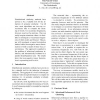322 search results - page 7 / 65 » Learning consumer preferences using semantic similarity |
93
Voted
NLE
2010
14 years 10 months ago
2010
Distributional similarity methods have proven to be a valuable tool for the induction of semantic similarity. Up till now, most algorithms use two-way cooccurrence data to compute...
89
Voted
CIARP
2004
Springer
15 years 5 months ago
2004
Springer
We present a method for extracting selectional preferences of verbs from unannotated text. These selectional preferences are linked to an ontology (e.g. the hypernym relations foun...
EMNLP
2008
15 years 1 months ago
2008
We consider a parsed text corpus as an instance of a labelled directed graph, where nodes represent words and weighted directed edges represent the syntactic relations between the...
COLING
2002
14 years 11 months ago
2002
The paper examines different possibilities to take advantage of the taxonomic organization of a thesaurus to improve the accuracy of classifying new words into its classes. The re...
WEBI
2005
Springer
15 years 5 months ago
2005
Springer
Structured link vector model (SLVM) is a recently proposed document representation that takes into account both structural and semantic information for measuring XML document simi...

